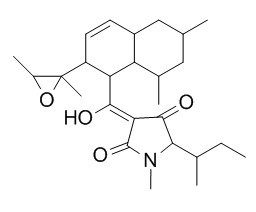Antibiotic PF 1052
Antibiotic PF 1052 is an antibacterial agent.
Inquire / Order:
manager@chemfaces.com
Technical Inquiries:
service@chemfaces.com
Tel:
+86-27-84237783
Fax:
+86-27-84254680
Address:
1 Building, No. 83, CheCheng Rd., Wuhan Economic and Technological Development Zone, Wuhan, Hubei 430056, PRC
Providing storage is as stated on the product vial and the vial is kept tightly sealed, the product can be stored for up to
24 months(2-8C).
Wherever possible, you should prepare and use solutions on the same day. However, if you need to make up stock solutions in advance, we recommend that you store the solution as aliquots in tightly sealed vials at -20C. Generally, these will be useable for up to two weeks. Before use, and prior to opening the vial we recommend that you allow your product to equilibrate to room temperature for at least 1 hour.
Need more advice on solubility, usage and handling? Please email to: service@chemfaces.com
The packaging of the product may have turned upside down during transportation, resulting in the natural compounds adhering to the neck or cap of the vial. take the vial out of its packaging and gently shake to let the compounds fall to the bottom of the vial. for liquid products, centrifuge at 200-500 RPM to gather the liquid at the bottom of the vial. try to avoid loss or contamination during handling.
Nanjing University of Chinese Medicine2022, 345930.
Molecules.2018, 23(7):E1817
Molecules.2017, 22(6)
SBRAS2016, 12
Nutrients.2022, 14(16):3393.
Food and Bioprocess Technology2017, 10(6):1074-1092
Front Pharmacol.2021, 12:652860.
Biochem Pharmacol.2017, 130:10-20
J Nat Prod.2021, 84(9):2544-2553.
Molecules.2018, 23(2)
Related and Featured Products
International Biodeterioration & Biodegradation, 2015, 104:411-418.
Interactions between fungi of standard paint test method BS3900.[Reference:
WebLink]
METHODS AND RESULTS:
Fungi are the principal deteriorating microflora on painted surfaces and standard test BS3900 uses a mixed fungal inoculum to assess anti-fungal agents in paint films. At the end of such a test with non-biocide containing (control) paint, Ulocladium atrum was shown by FESEM, culture and DGGE analysis to be the major surviving colonizer. Penicillium purpurogenum was also significant according to FESEM and culture results, and digital microscopy showed paint degrading activity.
METHODS AND RESULTS:
Laboratory studies on lab media showed that U. atrum had little antagonistic action against the other isolates used in the test, although it was one of the fastest growing fungi on malt extract agar. P. purpurogenum inhibited 10 of the other fungal isolates.
Secondary metabolites, which could be involved in fungal antagonistic activity, were detected in all but two of the filamentous fungi and none of the three yeasts used in the inoculum.
U. atrum produced the anti-fungal compound known as Antibiotic PF 1052. Although the three yeasts seemed to participate little in the final biofilm, they could be important in biocide assessment.



